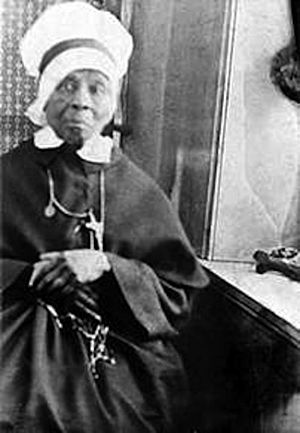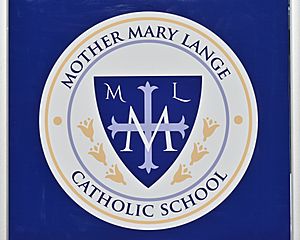Mary Elizabeth Lange facts for kids
Quick facts for kids Servant of GodMary Elizabeth Lange OSP |
|
|---|---|
 |
|
| Foundress | |
| Born | Elizabeth Clarisse Lange c. 1789 Santiago de Cuba, Spanish Cuba |
| Died | February 3, 1882 Baltimore, Maryland, United States |
| Venerated in | Catholic Church |
| Major shrine | Our Lady of Mount Providence Convent Baltimore City Maryland, United States |
| Feast | 3 February |
| Attributes | Religious habit Rosary |
| Patronage | Oblate Sisters of Providence |
Mary Elizabeth Lange, also known as Mother Mary Lange (born Elizabeth Clarisse Lange; around 1789 – February 3, 1882), was a very important Black Catholic religious sister. She started the Oblate Sisters of Providence. This was the first religious group for African-American women. Because of this, she also became the first African-American Mother Superior.
Her journey to possibly becoming a saint began in 1991. She is now honored with the title Servant of God.
Contents
Life Story of Mother Mary Lange
Her Early Years
Mary Elizabeth Lange was born in a place called San Domingo (now Haiti) around 1789. Her family had to leave their home during the Haitian Revolution. They moved to Santiago de Cuba, where she received an excellent education.
In the early 1800s, she left Cuba and moved to the United States. Oral stories from the Oblate Sisters say she first went to Charleston, South Carolina. Then she traveled to Norfolk, Virginia, and finally settled in Baltimore, Maryland by 1813. Baltimore was a good place for her. Many free African Americans lived there, and a large group of French-speaking people from the Caribbean had also moved there.
At that time, there were no free public schools for Black children in Baltimore. Mary Elizabeth Lange saw that many African-American children needed a good education. So, she opened a school in her own home in the Fells Point area of the city.
Starting a New Religious Group
In Baltimore, Lange met a French priest named James Nicholas Joubert. He was teaching catechism (religious lessons) to African-American children. Father Joubert noticed that the children struggled to learn because they couldn't read well. He thought it would be a great idea to start a school just for girls.
He also decided it would be good to start a new religious order for women at the same time. These women would teach the children. He asked Mary Elizabeth Lange and Marie Balas, who were already running a school, if they would join. They told him they felt called to serve God and had been waiting for a way to do it.
Father Joubert supported them and got permission from the Archbishop. On July 2, 1829, Lange and three other women took their first vows. Lange chose the name "Sister Mary" and became the first leader of the new group. They were called the Oblate Sisters of Providence. They were the first religious group for women of African descent in the United States. Their main goal was to provide Catholic education for girls.
The sisters started in a rented house with four sisters and twenty students. Their school later became known as St. Frances Academy. This school is still open today in Baltimore. The Oblate Sisters faced many challenges, including poverty and racism. But they worked hard to share their faith through education. They also offered night classes for women and helped widows and orphans.
In 1832, a serious illness called cholera spread through the city. The sisters volunteered to help the sick. Mary Elizabeth Lange and three other sisters were chosen to nurse the victims. Later, she worked at St. Mary’s Seminary to help support her community. In 1850, she became the "Mistress of novices." This meant she trained new sisters for ten years.
Mary Elizabeth Lange passed away on February 3, 1882. She was first buried in Cathedral Cemetery. Later, her remains were moved to New Cathedral Cemetery. Finally, in 2013, her remains were moved again to the chapel of the Oblate Sisters of Providence.
Mother Mary Lange's Lasting Impact
Mother Mary Lange's work has continued to grow over the years. Her legacy is strong in the United States and in other countries.
In 2005, three schools in Baltimore joined together to form the Mother Mary Lange Catholic School. This was the first school in America named after her. The school later closed.
In 2008, St. Frances Academy, the school she founded, celebrated its 180th anniversary.
A new Mother Mary Lange Catholic School opened in August 2021. It was the first new Catholic school in Baltimore in almost sixty years.
Honors and Recognition
In 1991, Mary Elizabeth Lange was honored and added to the Maryland Women's Hall of Fame. This was for the important school she founded. The work she began continues to help people today.
Becoming a Saint
After her death, many Catholics in Baltimore believed she was a saint.
In 1991, the Church officially began to study her life. This was to see if she could become a saint. As part of this process, she was given the title "Servant of God." Her remains were moved to the chapel of Our Lady of Mount Providence Convent. This is the main house of the Oblate Sisters of Providence.
In 2004, information about Mary Elizabeth Lange's life was sent to the Vatican. This is where the Church studies people who might become saints.


